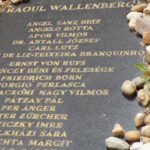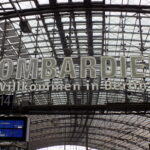
HUNGARY: Hungary is a landlocked country in Central Europe. Its capital, Budapest, is bisected by the Danube River. Its cityscape is studded with architectural landmarks from Buda’s medieval Castle Hill and grand neoclassical buildings along Pest’s Andrássy Avenue to the 19th-century Chain Bridge. Turkish and Roman influence on Hungarian culture includes the popularity of mineral spas, including at thermal Lake Hévíz
Arrived in Budapest, Hungary at about 10 past really late! Great train ride with a really strange compartment mate who consumed approximately two and a half cases of beer on the trip. The more he drank the louder he played the music on his I-pod. It wasn’t a problem, but it was an interesting experience. So we arrive in Budapest, first thing we realize is that the train station is huge, and has been there for 75 years at least. We struggle to find an exit, and the first thing we see when we walkout side is KFC! American fast food – great! Next door is a Burger King – I guess American’s are not satisfied with being the most obese nation in the world, we need to import our obesity. Sad. In general, Europeans eat in little cafe’s, and linger over food and company, enjoying conversation and living a bit slower than we do. Oh well, I have just landed here in Budapest and here I am being all judgy!
We discovered an ATM near the KFC so that we can get money in the local currency – the Forint. The Forint has been around since the first of August 1946, the name deriving from the city of Florence where gold coins were minted in the 1200s, a currency called the “florentinus” later came to Hungary in the 1300s, which later became the “forint”. Since the introduction of the current-day Forint in 1946 some note and coin designs have come and gone. For example, the 200 Ft bank note was phased out and just the coin of that value remains. The current set of notes were phased-in in 1997. The forint ranges in cash from 20,000 bill to the 500 forint bill. That was a bit disconcerting as I attempted to draw money out of the ATM, I got 25,000 forint and was mentally trying to calculate how that would impact my bank account – just because I know you are holding your breath – $93.71! I love Hungary! And I feel rich. So we decide that since it is late, dark and we have no idea where we are going we decided to take a Taxi (Taxi is taxi in every country), the driver looked at the address, told us that it was in zone one and would cost 20 Euros. Fortunately I had Euros with me, so we said that would be great. Turns out we were just a few blocks from the booked AirB&B William had booked, but it was still better than schlepping luggage. The place was great – two bedrooms and a nice bathroom with a washer – William books where we stay and I have yet to be disappointed, he is an awesome son!
Day 1 Budapest – what a beautiful city. We are just a couple of blocks from St. Stephan’s Basilica; Szent Istvan Bazilika, The Largest Church in Hungary is dedicated to Hungary’s first king, St. Stephen. … It houses Hungary’s most sacred treasure, St. Stephen’s mummified right hand, the Szent Jobb (Holy Right Hand).

So we hear the bells early in the morning. We stopped at a café and had breakfast and decided to walk across the bridge to Castle Hill. We crossed The Chain Bridge, it is a suspension bridge that spans the River Danube between Buda and Pest, the west and east side of Budapest. (To read a good book that takes place in Budapest, I highly recommend In The Darkroom, by Susan Faludi; it is the story of her relationship with her father who at 70 announces that he has had a sex change operation – that is quite an interesting story – but it takes place in Budapest, and you get to learn a bit about it.) Now, a word of caution to anyone that reads this – my son may have a bit different timeline than I – he is younger and has a more intact memory :-0 but the essence is from my memory – not his! So we arrive at Castle Hill – and we are approached by the Hop on/Hop off guy he saw us, and said to himself, “looks like American stupid tourist, they will buy!” And buy we did! We took the 48 hour pass that allowed a ticket to the Funicular, which is like a trolley that goes sideways up the hill….the we toured the Buda Castle. Don’t get too excited now, the original castle has been destroyed and rebuilt over the ages, and there is very little left of the original, but the chapel has been excavated, and it was pretty cool – as was the castle which is now a museum. The weapons of destruction, pictured below, sit outside the chapel where the guards lived, and below that is the chapel croft with altar – the next picture is the hammered copper doors – very, very cool!



Needless to say, there was a great deal of walking as we explored the Buda Castle, after we left it we took a ramble along the Danube looking for the pier for our evening cruise – we were on the wrong side of the Daube, it turns out, but it took a bit of time to figure it out. Once we did, it was back across the river and more exploration of Budapest – for historical information see: http://www.budapest.com/city_guide/general_information/history.en.html
Dinner at a local restaurant , I had Hungarian goulash – with a local beer – it was excellent. Then it was more walking and adventuring before the cruise. I can, in my inarticulate way say that Budapest is a fabulous city, relatively inexpensive ( If you can get pat paying 5,000 forint for a drink – realizing that it is less than 2$, and I have to highly recommend local everything – never, never miss the opportunity to buy local, eat local and talk to locals!)
These are some photo’s from the cruise – from the top – this exquisite building is the House of Parliament, it is in the Gothic Revival style, and one of the most beautiful buildings I have seen. It sits on the Danube (we did not visit it on this trip), and almost immediately in front of it is the Memorial of the shoes. The Shoes on the Danube Bank is a memorial in Budapest. Conceived by film director Can Togay, he created it on the east bank of the Danube with sculptor Gyula Pauer to honor the people (mainly Budapest Jews) who were killed by fascist Arrow Cross militiamen in Budapest during World War II. They were ordered to take off their shoes, and were shot at the edge of the water so that their bodies fell into the river and were carried away. It represents their shoes left behind on the bank. More tomorrow, but needless to say a very emotional sight. The bridge is part of the Chain Bridge that William and I trekked over several times, and the building in the rocks is actually a hospital. A very fascinating part of Hungarian history is located just beneath the Buda Castle Hill called the Hospital in the Rocks. This hospital was built during WWII, when Castle District was part of the Government Quarter. It was largely used when Budapest was under siege from July 1945 and then during the 1956 Revolution to treat wounded civilians and soldiers. Between 1958 and 1962 it was expanded to withstand potential chemical and nuclear attacks during the Cold War
In 1941, a section of the 6 mile stretch of interconnected caves and tunnels, was converted into a military hospital staffed from the civilian Szent János hospital. It was then reconstructed and fortified and used as an air raid shelter after the Red Army broke through the Attila Line and encircled Budapest in December 1944.
It was upgraded and extended to a nuclear bunker in the early ’60s because of the Cold War. Nowadays it is an exhibition displaying the life in the hospital with wax figures as well as the history of military surgery and civil defense. The control room and associated machinery are still in operating conditions.
The “Hospital in the Rock – Secret Emergency Hospital and Nuclear Bunker” opened to the public in 2008. Ramped throughout for wheelchairs and trolleys, its operating caves contain 1930s X-ray and anesthetic machines. The exhibition is a superb tourist attraction, it contains original medical equipment as well as some 70 gory wax figures. It is open from 10-18 daily except Monday. One-hour guided tours, available in Hungarian and English, depart every hour. Other parts of the Castle Hill cave system can be toured at the Labyrinth. The entrance to the hospital is at Lovas út 4/b, on the rear hillside beyond the castle walls, reached by descending the steps at the end of Szentháromság utca and then walking 50m uphill. Again – we did not visit this, but saw it from the river- it is on the list for the next visit! The you have Buda Castle from the river – and for my friends who have alwas wondered (as I have) about River cruising – there were two Viking River Cruisers on the Danube – and from what I could see, they looked pretty darn interesting! We saw the big Viking Tour Buses as well, these I assume make sure that you get to see the sights in the stop – and from the evident opulence I am beginning to understand why the cost is so high on the cruises! A European River Cruise is on the list as well. I can’t afford it but would be a willing passenger!
So ended the first full day in Budapest.

































 The Raoul Wallenberg Memorial Park with the Tree of Life.The silver metal weeping willow tree, the Tree of Life, stands in the Raoul Wallenberg Park (named after the Swedish diplomat who helped many Jews to escape from deportation in 1944-45). It is located in the garden of the synagogue and the Jewish Museum. It’s a very moving and sad monument created by Imre Varga in 1991 with the support of the Emmanuel Foundation (founded by Tony Curtis actor). Names of the victims disappeared or died during the Nazi terror are engraved on almost each of the 30,000 leaves.
The Raoul Wallenberg Memorial Park with the Tree of Life.The silver metal weeping willow tree, the Tree of Life, stands in the Raoul Wallenberg Park (named after the Swedish diplomat who helped many Jews to escape from deportation in 1944-45). It is located in the garden of the synagogue and the Jewish Museum. It’s a very moving and sad monument created by Imre Varga in 1991 with the support of the Emmanuel Foundation (founded by Tony Curtis actor). Names of the victims disappeared or died during the Nazi terror are engraved on almost each of the 30,000 leaves.










































